Demand Forecasting of Online Car-Hailing with Combining LSTM + Attention Approaches
Abstract
:1. Introduction
2. Literature Review
3. Methodology
3.1. Long Short-Term Memory
3.2. Attention Mechanism
3.3. LSTM + Attention
4. Data Analysis and Results
4.1. Time Features
4.2. Spatial Features
4.3. Weather Features
5. Case Analysis
5.1. Data Source and Preprocessing
5.2. Error Evaluation Index and Parameter Selection
5.3. Analysis of Predicted Results
6. Application
7. Conclusions
Author Contributions
Funding
Data Availability Statement
Acknowledgments
Conflicts of Interest
References
- Ye, X.F.; Li, M.; Yang, Z.; Yan, X.C.; Chen, J. A Dynamic Adjustment Model of Cruising Taxicab Fleet Size Combined the Operating and Flied Survey Data. Sustainability 2020, 12, 2776. [Google Scholar] [CrossRef] [Green Version]
- Jin, Y.M.; Ye, X.F.; Ye, Q.M.; Wang, T.; Chen, J.; Yan, X.C. Demand Forecasting of Online Car-Hailing With Stacking Ensemble Learning Approach and Large-Scale Datasets. IEEE Access 2020, 8, 199513–199523. [Google Scholar] [CrossRef]
- Chen, X.W. Research on Short-term Traffic Flow Forecasting Model Based on LSTM. J. World Sci. Res. 2020, 6, 12–19. [Google Scholar]
- Zhang, W.; Yu, Y.; Qi, Y. Short-term traffic flow prediction based on spatio-temporal analysis and CNN deep learning. Transportmetrica 2019, 15, 1688–1711. [Google Scholar] [CrossRef]
- Li, D.Z.; Lin, C.; Gao, W. Capsules TCN Network for Urban Computing and Intelligence in Urban Traffic Prediction. Wirel. Commun. Mob. Comput. 2020, 2020, 6896579. [Google Scholar] [CrossRef]
- Ma, X.L.; Dai, Z.; He, Z.B. Learning Traffic as Images: A Deep Convolutional Neural Network for Large-Scale Transportation Network Speed Prediction. Sensors 2017, 17, 818. [Google Scholar] [CrossRef] [PubMed] [Green Version]
- Wang, D.; Yang, Y.; Ning, S. DeepSTCL: A Deep Spatio-temporal ConvLSTM for Travel Demand Prediction. In Proceedings of the 2018 International Joint Conference on Neural Networks (IJCNN), Rio de Janeiro, Brazil, 8–13 July 2018; pp. 1–8. [Google Scholar] [CrossRef]
- Xu, M.; Liu, H.F.; Chu, K. Spatiotemporal demand prediction of bike sharing based on AM-LSTM model. J. Hunan Univ. (Nat. Sci. Ed.) 2020, 47, 77–85. [Google Scholar]
- Wu, Y.; Tan, H. Short-term traffic flow forecasting with spatial-temporal correlation in a hybrid deep learning framework. Comput. Vis. Pattern Recognit. 2016, 23, 33–41. [Google Scholar]
- Ma, F.H.; Rao, Z.Q. Study on short term traffic flow prediction method of urban road. Highway 2017, 62, 192–196. [Google Scholar]
- Xu, L.H.; Guo, Y.T. Short term forecasting model of online car Hailing demand based on GWO-LSTM. Autom. Instrum. 2020, 35, 86–90. [Google Scholar]
- Yao, H.; Wu, F.; Ke, J. Deep Multi-View Spatial-Temporal Network for Taxi Demand Prediction. Mach. Learn. 2018, 16, 76–83. [Google Scholar]
- Xu, Y.; Li, D.S. Incorporating Graph Attention and Recurrent Architectures for City-Wide Taxi Demand Prediction. ISPRS Int. J. Geo-Inf. 2019, 8, 414. [Google Scholar] [CrossRef] [Green Version]
- Duan, Z.T.; Zhang, K.; Yang, Y.; Ni, Y.Y. Taxi demand forecasting based on deep CNN LSTM RESNET combination model. Transp. Syst. Eng. Inf. 2018, 18, 215–223. [Google Scholar]
- Nejadettehad, A.; Mahini, H.; Bahrak, B. Short-term Demand Forecasting for Online Car-hailing Services Using Recurrent Neural Networks. Mach. Learn. 2020, 34, 674–689. [Google Scholar] [CrossRef]
- Huang, M.; Mao, F.; Qian, Y.X.; Sha, Z.R. Prediction of taxi demand based on dropconnect’s correlationnet. J. Sun Yat Sen Univ. (Nat. Sci. Ed.) 2020, 59, 86–94. [Google Scholar]
- Ke, J.; Feng, S.; Zhu, Z.; Yang, H.; Ye, J. Joint predictions of multi-modal ride-hailing demands: A deep multi-task multi-graph learning-based approach. Transp. Res. Part C Emerg. Technol. 2021, 127, 103063. [Google Scholar] [CrossRef]
- Miao, H.; Fei, Y.; Wang, S.; Wang, F.; Wen, D. Deep learning based origin-destination prediction via contextual information fusion. Multimed. Tools Appl. 2021, 1–17. [Google Scholar] [CrossRef]
- Chao, L.M.; Bo, L.J.; Jie, F.J.; Ying, L.; Ba, D. Multi factor spatiotemporal convolution network for taxi demand forecasting. Comput. Eng. Appl. 2020, 56, 266–273. [Google Scholar]
- Hochreiter, S.; Schmidhuber, J.R. Long Short-Term Memory. Neural Comput. 1997, 9, 1735–1780. [Google Scholar] [CrossRef] [PubMed]
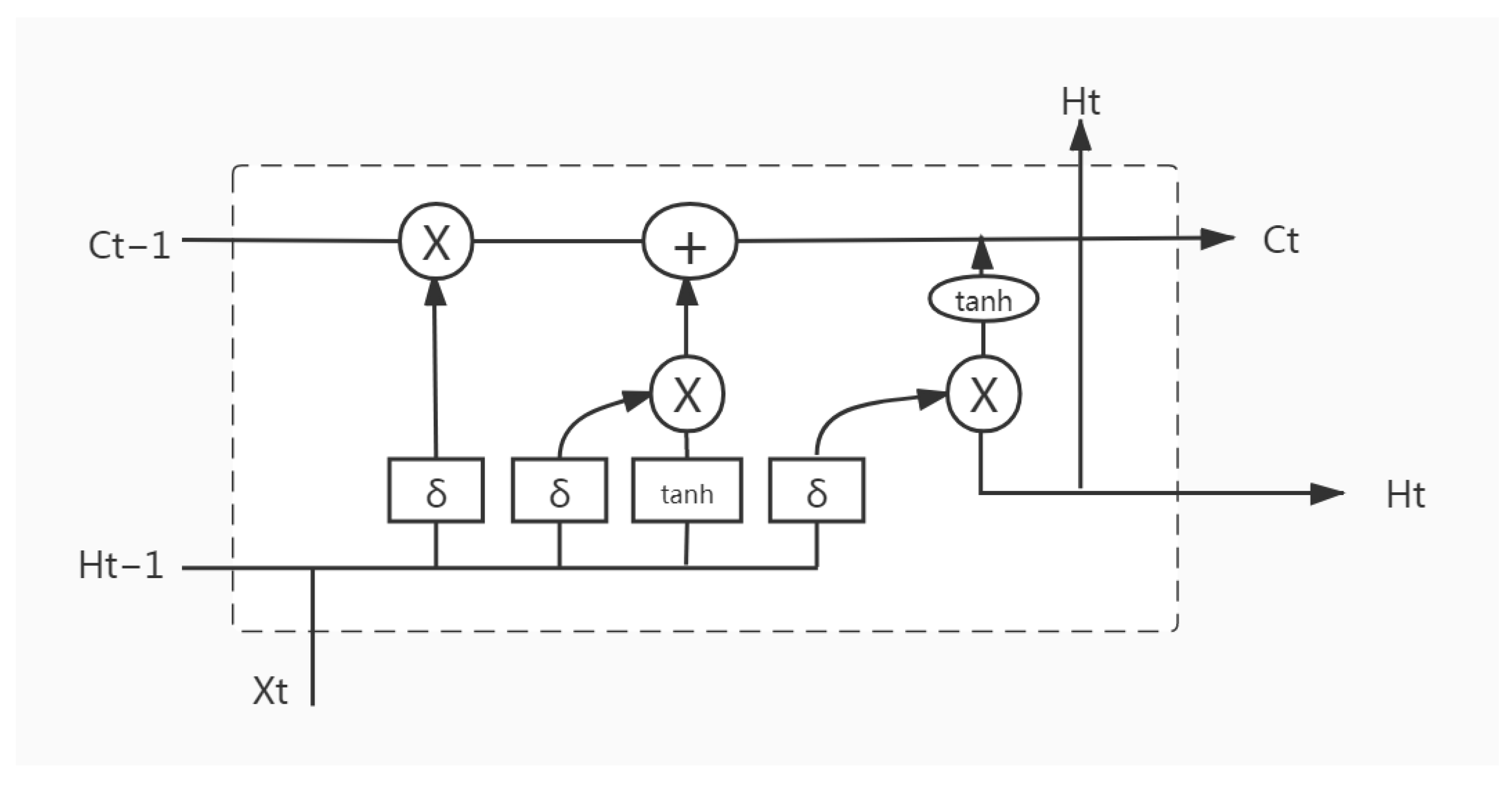
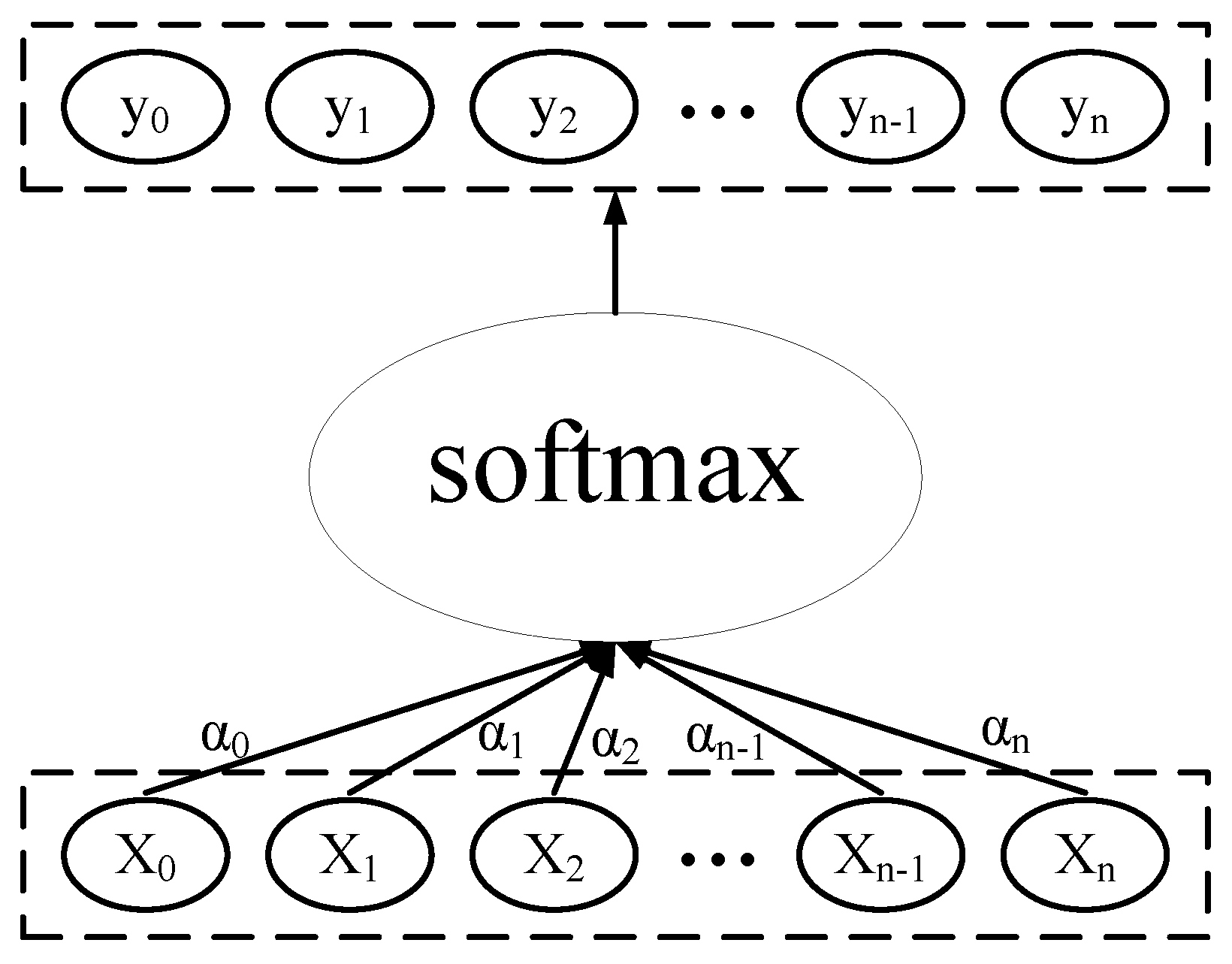
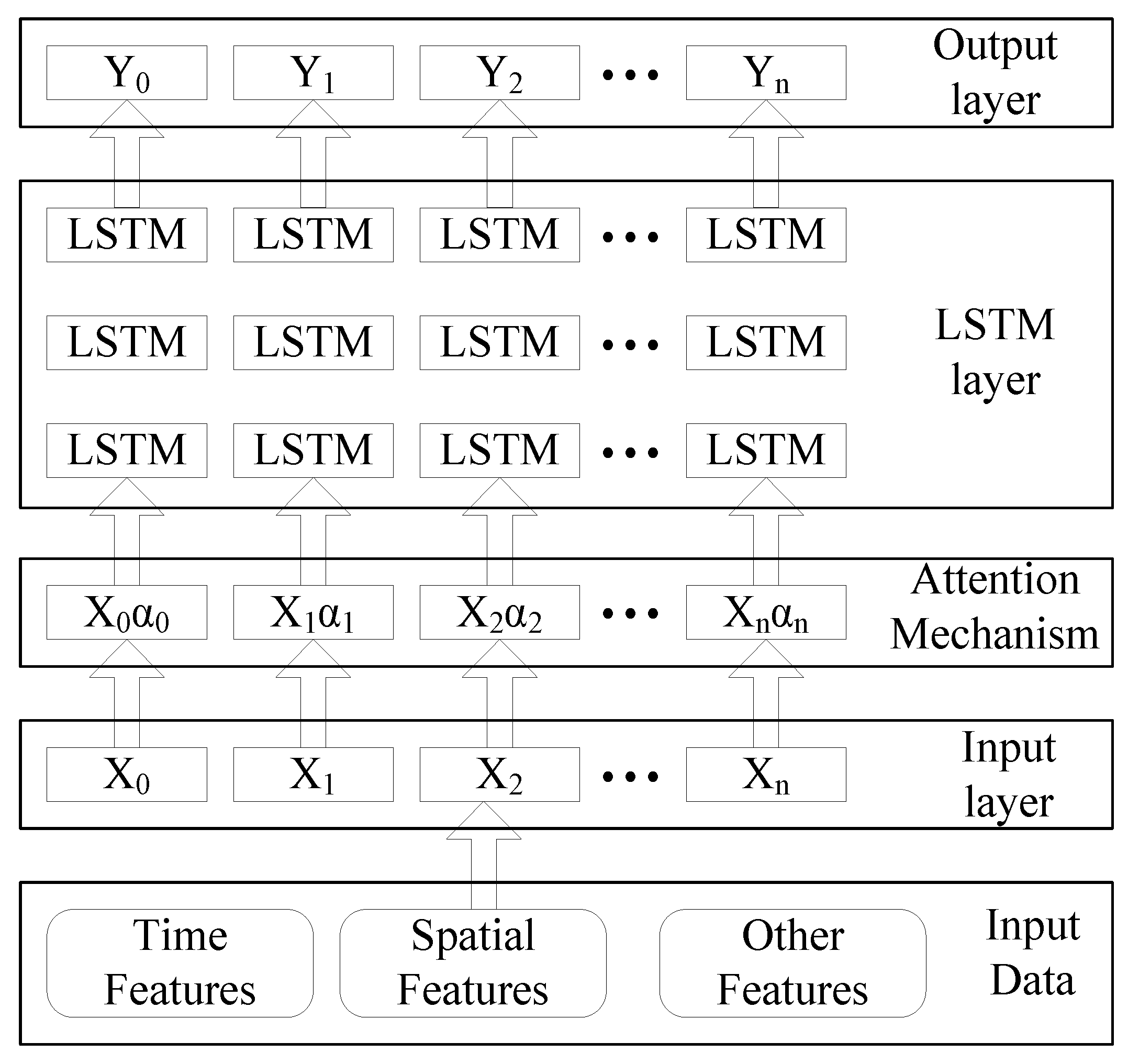

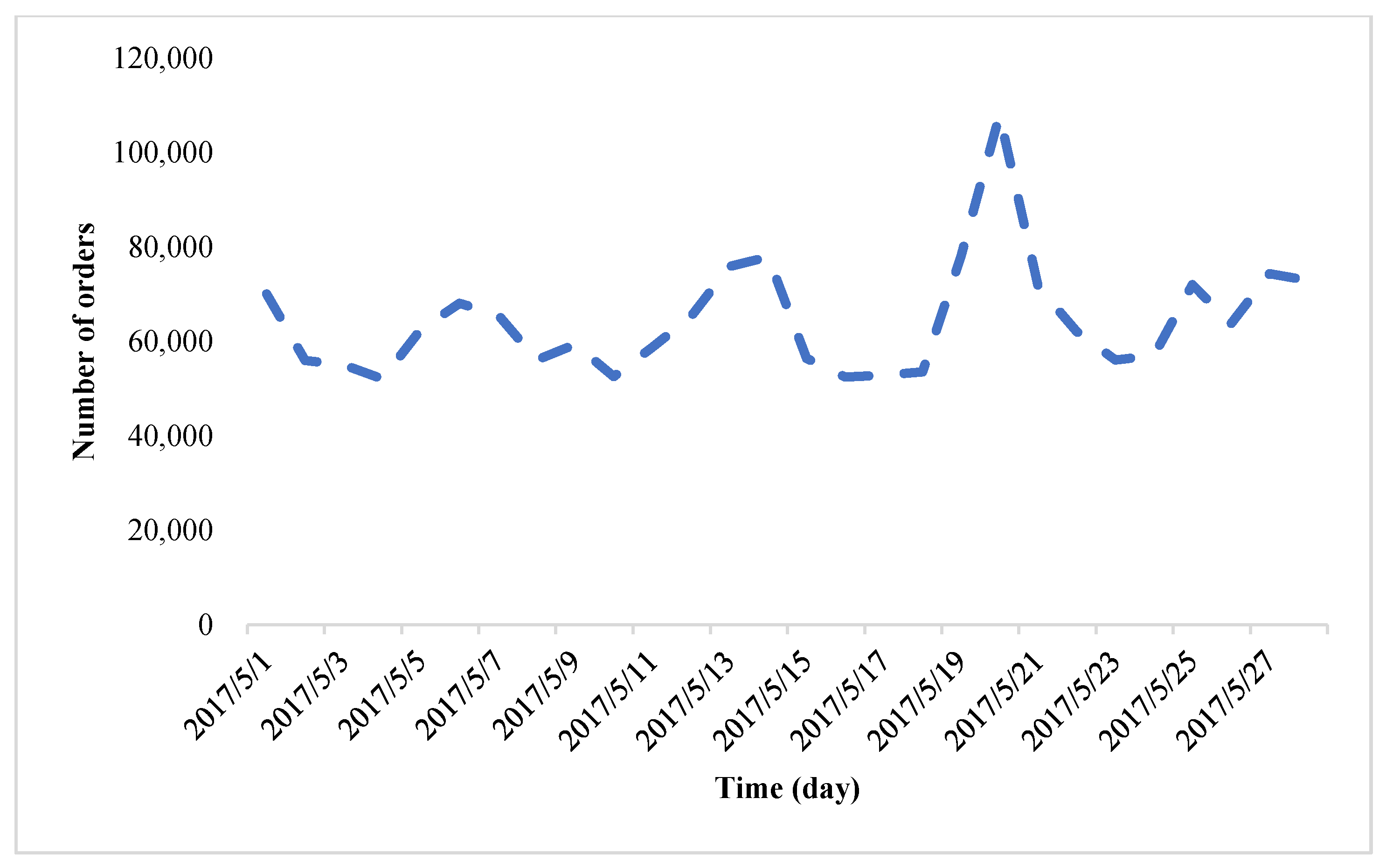
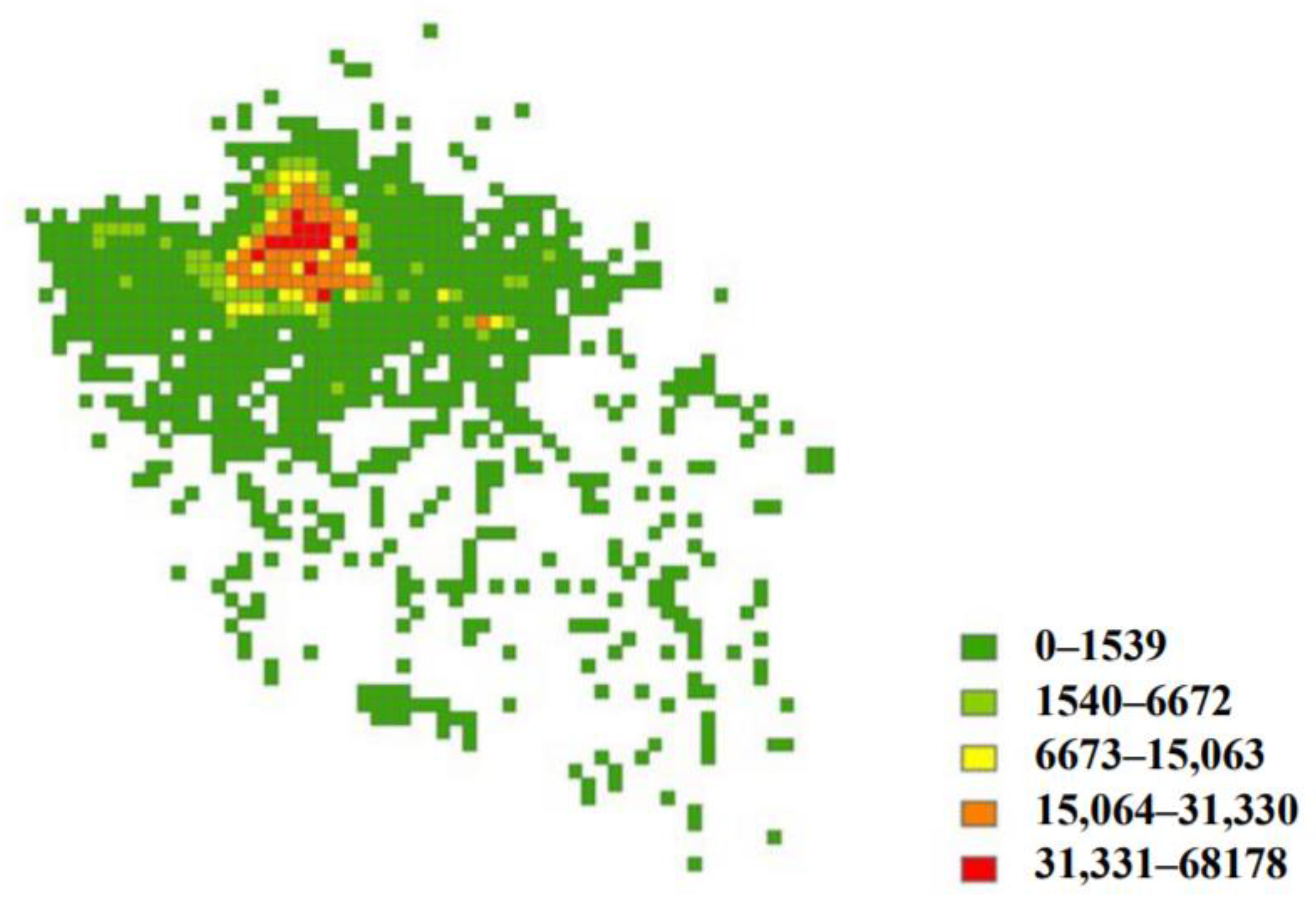

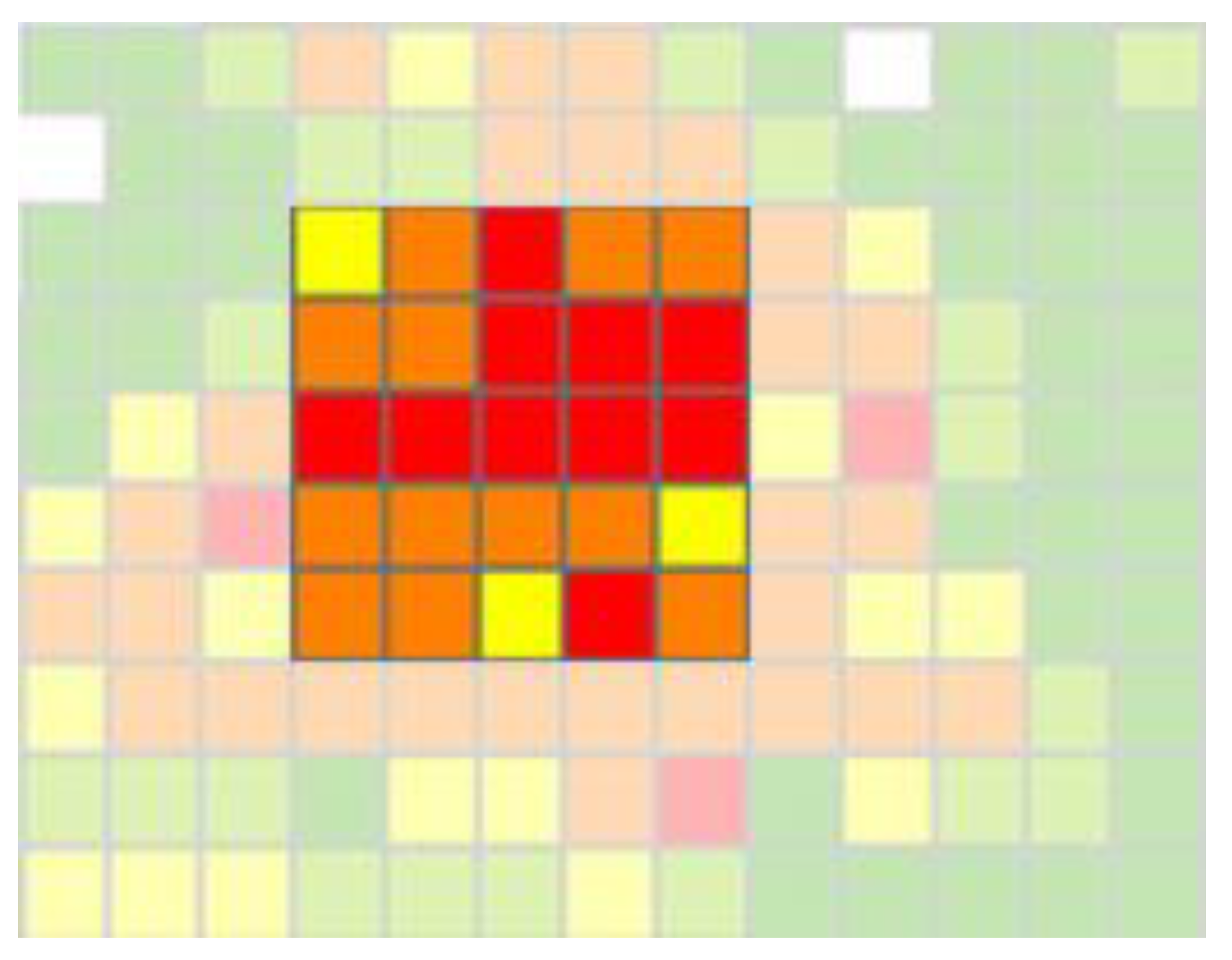

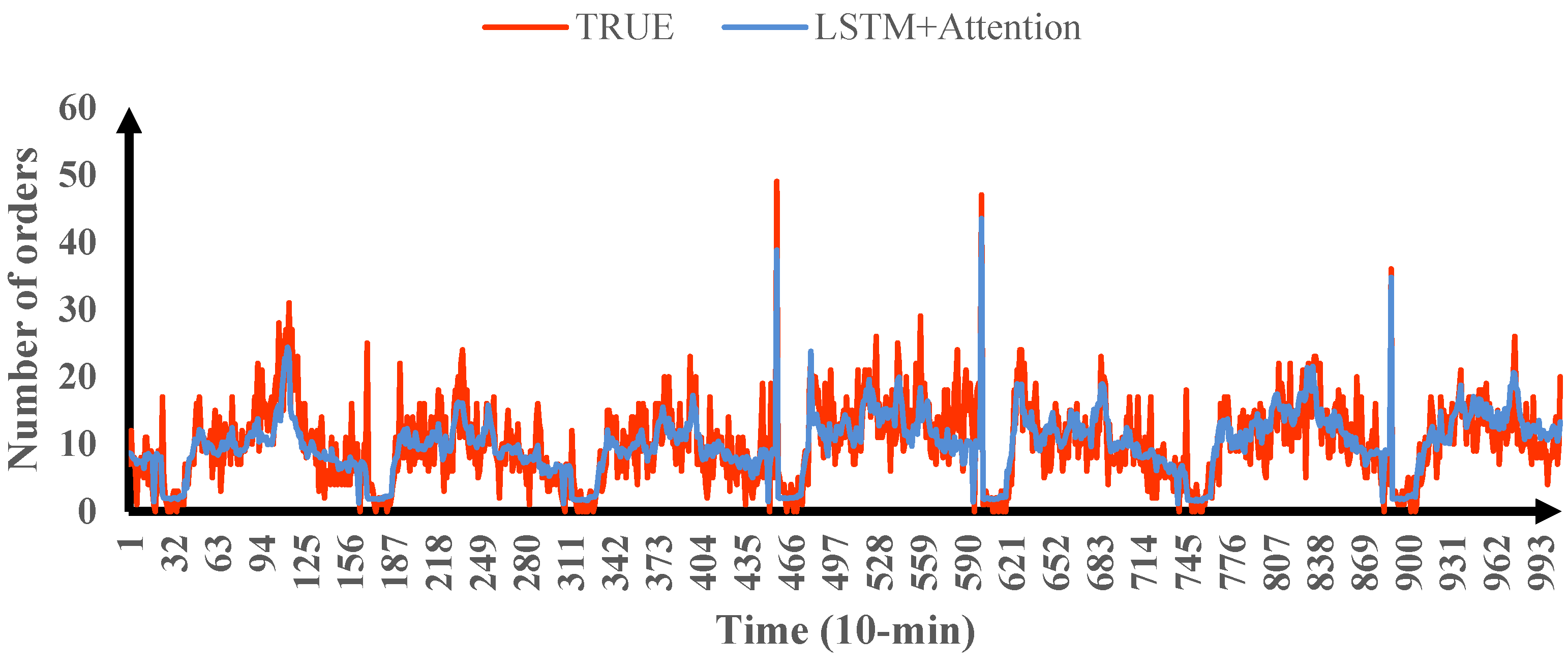
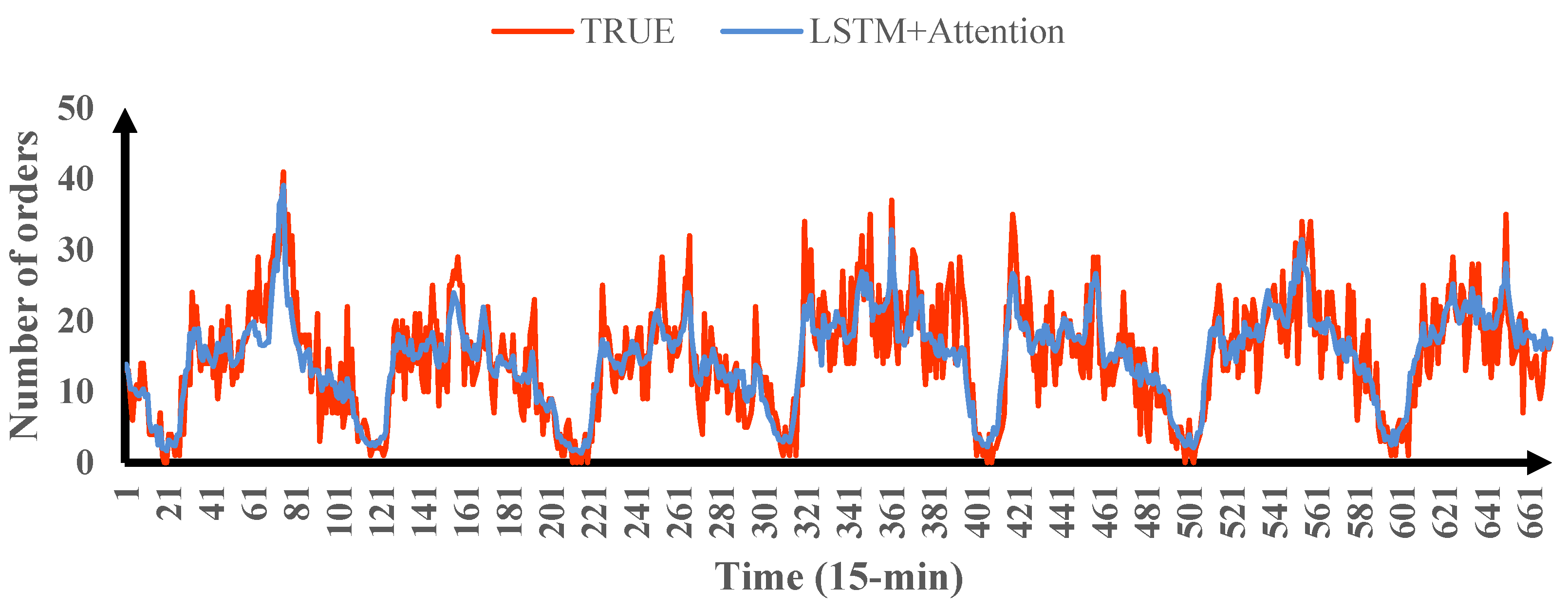
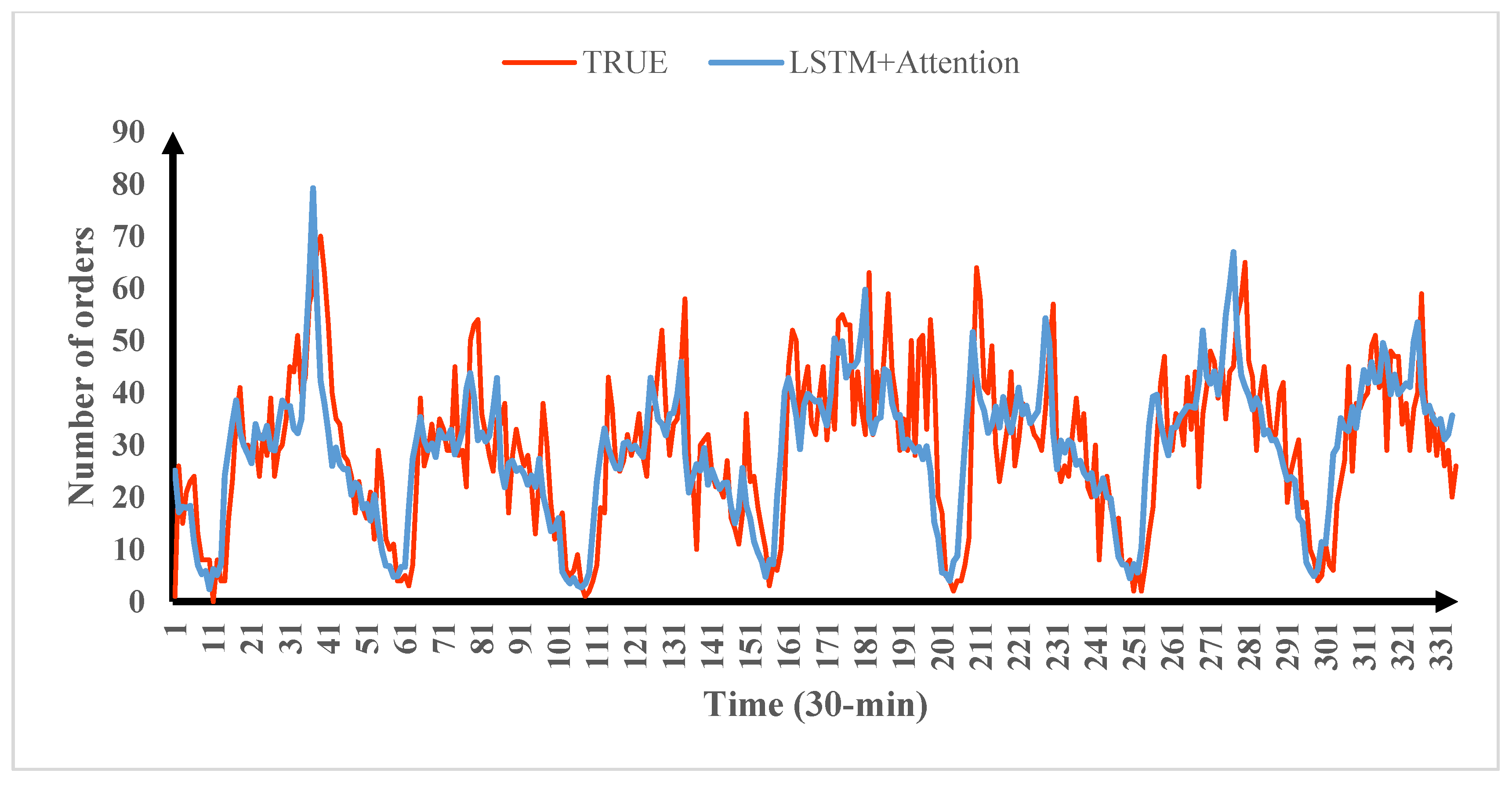
| Type | Number of Similar Areas | Proportion |
|---|---|---|
| Type 1 | 15 | 60% |
| Type 2 | 7 | 28% |
| Type 3 | 3 | 12% |
| Parameter Name | 10 min | 15 min | 30 min |
|---|---|---|---|
| Hidden layer | 3 | 3 | 3 |
| Number of neurons | 64/32/16 | 64/32/16 | 128/64/32 |
| Time step | 1 | 1 | 1 |
| Activation function | relu | relu | relu |
| Optimization function | Adam | Adam | Adam |
| Dropout rate | 0.2 | 0.1 | 0.2 |
| Learning_rate | 0.01 | 0.01 | 0.01 |
| Batch_size | 160 | 150 | 220 |
| Epoch numbers | 100 | 50 | 75 |
| Model | 10 min | 15 min | 30 min | |||
|---|---|---|---|---|---|---|
| MSE | MAE | MSE | MAE | MSE | MAE | |
| GBDT | 26.805 | 3.848 | 33.661 | 4.256 | 90.131 | 7.1284 |
| BPNN | 24.086 | 3.771 | 25.630 | 3.936 | 71.650 | 6.273 |
| RNN | 22.298 | 3.299 | 24.268 | 3.782 | 64.936 | 6.059 |
| LSTM | 21.841 | 3.3026 | 23.201 | 3.712 | 62.724 | 5.937 |
| LTSM + Attention | 18.100 | 3.015 | 19.949 | 3.472 | 56.854 | 5.680 |
Publisher’s Note: MDPI stays neutral with regard to jurisdictional claims in published maps and institutional affiliations. |
© 2021 by the authors. Licensee MDPI, Basel, Switzerland. This article is an open access article distributed under the terms and conditions of the Creative Commons Attribution (CC BY) license (https://creativecommons.org/licenses/by/4.0/).
Share and Cite
Ye, X.; Ye, Q.; Yan, X.; Wang, T.; Chen, J.; Li, S. Demand Forecasting of Online Car-Hailing with Combining LSTM + Attention Approaches. Electronics 2021, 10, 2480. https://doi.org/10.3390/electronics10202480
Ye X, Ye Q, Yan X, Wang T, Chen J, Li S. Demand Forecasting of Online Car-Hailing with Combining LSTM + Attention Approaches. Electronics. 2021; 10(20):2480. https://doi.org/10.3390/electronics10202480
Chicago/Turabian StyleYe, Xiaofei, Qiming Ye, Xingchen Yan, Tao Wang, Jun Chen, and Song Li. 2021. "Demand Forecasting of Online Car-Hailing with Combining LSTM + Attention Approaches" Electronics 10, no. 20: 2480. https://doi.org/10.3390/electronics10202480
APA StyleYe, X., Ye, Q., Yan, X., Wang, T., Chen, J., & Li, S. (2021). Demand Forecasting of Online Car-Hailing with Combining LSTM + Attention Approaches. Electronics, 10(20), 2480. https://doi.org/10.3390/electronics10202480







